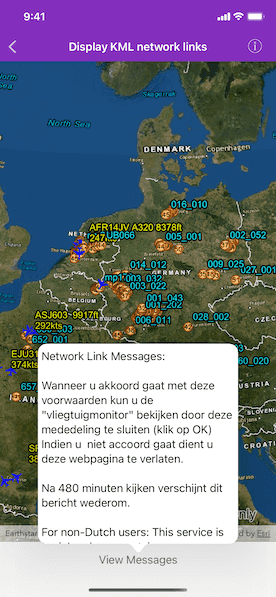Display a file with a KML network link, including displaying any network link control messages at launch.

Use case
KML files can reference other KML files on the network and support automatically refreshing content. For example, survey workers will benefit from KML data shown on their devices automatically refreshing to show the most up-to-date state. Additionally, discovering KML files linked to the data they are currently viewing provides additional information to make better decisions in the field.
How to use the sample
The sample will load the KML file automatically. The data shown should refresh automatically every few seconds. Tap the bottom button to view messages. Pan and zoom to explore the map.
How it works
- Create an
AGSKMLDatasetfrom a KML source that has network links. - Construct an
AGSKMLLayerwith the dataset and add the layer to the map'soperationalLayersarray. - To listen for network messages, use the KML dataset's
networkLinkMessageHandler.
Relevant API
- AGSKMLDataset
- AGSKMLDataset.networkLinkMessageHandler
- AGSKMLLayer
Offline data
This sample uses the radar.kmz file, which can be found on ArcGIS Online.
About the data
This map shows the current air traffic in parts of Europe with heading, altitude, and ground speed. Additionally, noise levels from ground monitoring stations are shown.
Tags
Keyhole, KML, KMZ, Network Link, Network Link Control, OGC
Sample Code
// Copyright 2018 Esri.
//
// Licensed under the Apache License, Version 2.0 (the "License");
// you may not use this file except in compliance with the License.
// You may obtain a copy of the License at
//
// http://www.apache.org/licenses/LICENSE-2.0
//
// Unless required by applicable law or agreed to in writing, software
// distributed under the License is distributed on an "AS IS" BASIS,
// WITHOUT WARRANTIES OR CONDITIONS OF ANY KIND, either express or implied.
// See the License for the specific language governing permissions and
// limitations under the License.
import UIKit
import ArcGIS
class DisplayKMLNetworkLinksViewController: UIViewController {
@IBOutlet weak var sceneView: AGSSceneView!
/// The controller shown in a popover after tapping "View Messages"
private weak var messageViewController: KMLNetworkMessagesViewController?
private var messageText = "Network Link Messages:\n\n" {
didSet {
updatePopoverForMessage()
}
}
override func viewDidLoad() {
super.viewDidLoad()
// Add the source code button item to the right of navigation bar.
(navigationItem.rightBarButtonItem as! SourceCodeBarButtonItem).filenames = ["DisplayKMLNetworkLinksViewController"]
// instantiate a scene using labeled imagery basemap
let scene = AGSScene(basemapStyle: .arcGISImagery)
// set the view's scene
sceneView.scene = scene
// create and set a viewpoint centered on the data coverage
let viewpoint = AGSViewpoint(center: AGSPoint(x: 8.150526, y: 50.472421, spatialReference: .wgs84()), scale: 10000000)
sceneView.setViewpoint(viewpoint)
/// The URL of a KML file with network links
let datasetURL = URL(string: "https://www.arcgis.com/sharing/rest/content/items/600748d4464442288f6db8a4ba27dc95/data")!
/// The KML dataset with network links
let kmlDataset = AGSKMLDataset(url: datasetURL)
// register to receive the network link messages
kmlDataset.networkLinkMessageHandler = { [weak self] (_, message) in
// run UI updates on the main thread
DispatchQueue.main.async {
// append the message to the prior messages
self?.messageText += "\(message)\n\n"
}
}
/// The layer used to display the KML data
let kmlLayer = AGSKMLLayer(kmlDataset: kmlDataset)
// add the layer to the scene
scene.operationalLayers.add(kmlLayer)
}
private func updatePopoverForMessage() {
// updates the text shown in the text view with the message text
messageViewController?.textView?.text = messageText
}
override func prepare(for segue: UIStoryboardSegue, sender: Any?) {
// The popovover segue is triggered via storyboard connections, so set it up here.
if let controller = segue.destination as? KMLNetworkMessagesViewController {
controller.presentationController?.delegate = self
controller.preferredContentSize = CGSize(width: 300, height: 300)
// load the view so the text view can be accessed now
controller.loadViewIfNeeded()
// retain a reference to the controller so the text view can be updated from `updatePopoverForMessage()`
messageViewController = controller
// set the initial message
updatePopoverForMessage()
}
}
}
extension DisplayKMLNetworkLinksViewController: UIAdaptivePresentationControllerDelegate {
func adaptivePresentationStyle(for controller: UIPresentationController, traitCollection: UITraitCollection) -> UIModalPresentationStyle {
// show as this as a popover even on small displays
return .none
}
}
class KMLNetworkMessagesViewController: UIViewController {
@IBOutlet var textView: UITextView!
}